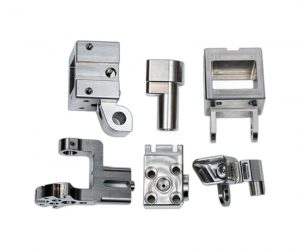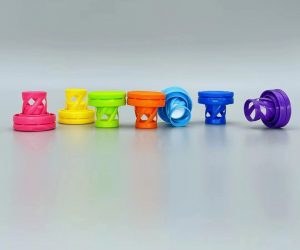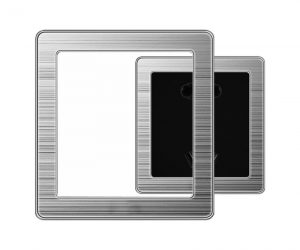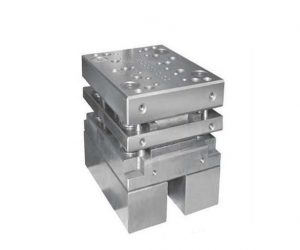1. Introduction: The Synergy of Bakelite and Injection Molding
In the dynamic landscape of industrial manufacturing, phenolic resin, more commonly recognized by its commercial moniker Bakelite, has long been a cornerstone material celebrated for its remarkable properties. Since its invention in the early 20th century, Bakelite has found its way into a vast array of applications, from the mundane to the highly specialized, owing to its exceptional thermal resistance, electrical insulation capabilities, and mechanical stability.
Bakelite, a thermosetting plastic, is formed through the polymerization of phenol and formaldehyde under the influence of heat and pressure, often in the presence of a catalyst. This chemical reaction results in a cross - linked polymer structure that imparts Bakelite with its characteristic rigidity and durability. The unique molecular architecture of Bakelite is what enables it to withstand high temperatures without significant degradation, making it ideal for applications where heat resistance is crucial, such as in electrical appliances, automotive engines, and industrial machinery.
Injection molding, on the other hand, is a high - volume manufacturing process that has revolutionized the production of plastic parts. This process involves injecting molten material into a mold cavity, where it cools and solidifies to take the shape of the mold. Injection molding offers several advantages, including high production rates, excellent dimensional accuracy, and the ability to produce complex shapes with fine details. When combined with Bakelite, injection molding becomes a powerful technique for creating precision components used in a wide range of industries.
Bakelite injection molding has become a pivotal process for transforming this versatile material into high - quality, precision - engineered components. In the realm of electrical appliances, Bakelite parts are used in switches, sockets, and insulators, where their electrical insulating properties and heat resistance are essential for safe and reliable operation. In the automotive industry, Bakelite components are found in engine parts, such as valve covers and distributor caps, due to their ability to withstand the high temperatures and mechanical stresses present in the engine compartment. Additionally, Bakelite injection - molded parts are used in industrial tools, where their durability and chemical resistance make them suitable for use in harsh working environments.
This article delves deep into the intricate steps, technical nuances, and innovative practices that define the production of phenolic resin parts through Bakelite injection molding. By meticulously dissecting the material preparation, mold design, process optimization, and quality control aspects, Yigu Technology aim to uncover how this technology seamlessly balances the rich heritage of Bakelite with modern engineering principles to deliver high - performance components that meet the stringent demands of today's industries. Whether you are a seasoned engineer looking to optimize your Bakelite injection molding process or a novice seeking to understand the fundamentals of this fascinating technology, this article will provide you with valuable insights and practical knowledge.
2. Material Foundation: Preparing Phenolic Resin for Molding
2.1. Resin Formulation and Preprocessing
The journey of creating high - quality phenolic resin parts through Bakelite injection molding begins with meticulous material preparation. The phenolic resin used in injection molding typically arrives in the form of granular or powdered thermoset material. This base resin is often enhanced by blending it with fillers such as wood flour or glass fibers, along with various additives, to achieve the desired mechanical properties in the final product.
One of the initial and crucial preprocessing steps is drying. Moisture can be a nemesis in the injection molding process. Even a small amount of moisture in the phenolic resin can lead to the formation of voids in the final part, compromising its structural integrity and aesthetic appeal. To prevent this, the moisture content of the resin must be reduced to less than 0.5%. Industrial ovens are commonly employed for this task. The resin is heated to a temperature range of 80 - 100°C for a period of 2 - 4 hours. The exact time depends on the particle size of the resin; smaller particles generally require less drying time as they have a larger surface - to - volume ratio, allowing for more efficient moisture evaporation.
Mixing is another vital step in the preprocessing stage. Fillers are added to the resin in significant proportions, typically accounting for 20 - 40% by weight. For instance, glass fiber reinforcement is a popular choice due to its ability to enhance the dimensional stability of the final part and reduce shrinkage. When 30% glass fiber is added to the phenolic resin, it can significantly decrease the linear shrinkage from 0.8% to 0.3%. This reduction in shrinkage is crucial for parts that require tight tolerances, such as those used in precision engineering applications. The mixing process aims to homogenize the fillers with the resin, ensuring an even distribution of the filler material throughout the resin matrix. This uniform distribution is essential for achieving consistent mechanical properties in all parts produced. High - shear mixers are often used to ensure thorough blending, as they can break down any agglomerates of filler particles and disperse them evenly in the resin.
2.2. Material Characterization
Understanding the characteristics of the phenolic resin is fundamental to a successful injection molding process. One of the key properties to consider is the resin's flow behavior. Phenolic resins exhibit a viscosity range of at molding temperatures, which typically fall within the range of 160 - 190°C. This viscosity range directly impacts the injection pressure required to fill the mold cavity. To fill complex molds with intricate geometries, injection pressures between are often necessary. If the injection pressure is too low, the resin may not fully fill the mold, resulting in incomplete parts. On the other hand, if the pressure is too high, it can cause issues such as flash (excess material oozing out of the mold), mold damage, or internal stresses in the part.
A comparative analysis of the properties of unfilled and filled phenolic resins provides valuable insights. The following Yigu Technology table highlights some of the key differences:
| Property | Unfilled Phenolic | 30% Glass Fiber - Reinforced |
| Tensile Strength (MPa) | 45 - 60 | 80 - 100 |
| Thermal Conductivity (W/m·K) | 0.35 | 0.65 |
| Mold Shrinkage (%) | 0.6 - 1.0 | 0.2 - 0.5 |
As shown in the Yigu Technology table, the addition of 30% glass fiber significantly enhances the tensile strength of the phenolic resin, making it more suitable for applications that require high - strength components. The thermal conductivity also increases, which can be beneficial in applications where heat dissipation is important, such as in some electronic components. Additionally, the reduction in mold shrinkage, as previously mentioned, is a significant advantage for parts that demand high - dimensional accuracy. By understanding these property differences, manufacturers can make informed decisions about the resin formulation based on the specific requirements of the parts they are producing.
3. Mold Design: The Blueprint for Precision
3.1. Mold Material Selection
The mold design in Bakelite injection molding is akin to creating a blueprint for a high - precision manufacturing process. It is a critical stage that significantly influences the quality, efficiency, and cost - effectiveness of the production of phenolic resin parts. The choice of mold material is the first and one of the most crucial decisions in this process.
Yigu Technology Molds for Bakelite molding must endure harsh conditions. During the injection molding process, they are subjected to high temperatures, typically in the range of 150 - 180°C, and high pressures, usually between 100 - 200 MPa. These extreme conditions require materials that can maintain their structural integrity and dimensional stability over extended production runs.
Tool steel grades, such as H13, are highly preferred for Bakelite injection molding molds. H13 tool steel has a hardness of 48 - 52 HRC (Rockwell Hardness C - scale), which provides excellent wear resistance. This wear resistance is essential as the mold comes into repeated contact with the molten Bakelite resin, which can cause abrasion over time. Additionally, H13 steel has good heat - resistance properties, allowing it to withstand the high temperatures involved in the molding process without significant deformation or degradation.
However, for low - volume production or prototyping, aluminum alloys may be a more cost - effective alternative. Aluminum alloys are much lighter than tool steels, which can simplify the handling and installation of the mold. They also have a relatively high thermal conductivity, which can aid in the heat transfer during the molding process, potentially reducing cycle times. But they are not as durable as tool steels and may not be suitable for high - volume production due to their lower hardness and wear resistance.
When designing the mold, several key aspects need to be carefully considered. One of these is the gating system. The gating system is responsible for controlling the flow of the molten Bakelite resin into the mold cavity. Edge gates or submarine gates are commonly employed. Edge gates are simple and easy to manufacture. They are located at the edge of the mold cavity and allow the resin to enter the cavity in a relatively straightforward manner. Submarine gates, on the other hand, are hidden beneath the surface of the mold and are less visible in the final part, which is beneficial for parts where surface aesthetics are important. The gate diameter typically ranges from 1.5 - 3mm. This diameter range is crucial as it helps to balance the flow speed of the resin and the solidification time. If the gate diameter is too small, the resin may not flow smoothly into the mold, leading to incomplete filling or high - pressure drops during injection. Conversely, if the gate diameter is too large, the resin may flow too quickly, causing issues such as flash (excess material oozing out of the mold) and uneven filling.
Ventilation is another critical aspect of mold design. Fine vents, typically with a width of 0.03 - 0.05mm, are placed along the parting lines of the mold. These vents play a vital role in preventing air traps. During the injection of the molten resin, air within the mold cavity needs to be expelled. If air is trapped, it can cause burn marks in the resin. Burn marks occur when the trapped air is compressed by the incoming resin, leading to a rapid increase in temperature due to adiabatic compression. This high temperature can char or burn the Bakelite resin, resulting in a defective part. By providing proper ventilation, the air can escape smoothly, ensuring a high - quality molding process.
3.2. Cooling and Heating Systems
Unlike thermoplastic injection molding, where the focus is mainly on cooling the molten material to solidify it, Bakelite injection molding requires precise heating to initiate the cross - linking process. The cross - linking of the phenolic resin is a chemical reaction that occurs when the resin is exposed to heat and pressure. This reaction transforms the linear polymer chains of the resin into a three - dimensional network structure, giving Bakelite its characteristic strength and rigidity.
Mold temperature controllers are essential components in Bakelite injection molding. These controllers maintain a uniform temperature within the mold, often using electric cartridge heaters or fluid - based systems. Electric cartridge heaters are small, cylindrical heating elements that are inserted into the mold. They can provide precise and rapid heating, allowing for quick adjustments to the mold temperature. Fluid - based systems, on the other hand, use a heated fluid, such as oil or water, to transfer heat to the mold. These systems can provide more uniform heating over a larger area and are often preferred for larger molds.
Once the cross - linking process is initiated, rapid cooling is required to complete the curing stage. This is typically achieved through chilled water channels within the mold. The chilled water absorbs the heat from the mold, causing the Bakelite to cool and solidify. The cooling rate is a critical factor as it affects the quality and properties of the final part. If the cooling is too slow, the part may experience warping or shrinkage. On the other hand, if the cooling is too rapid, internal stresses may develop within the part, leading to cracking or reduced mechanical strength.
The cycle times in Bakelite injection molding can vary depending on several factors, but they typically range from 30 - 90 seconds per shot. The main factor influencing the cycle time is the wall thickness of the part. Thicker - walled parts require more time for the heat to penetrate and initiate cross - linking, as well as more time for cooling. For Yigu Technology example, a part with a wall thickness of 2mm may have a cycle time of around 45 seconds, while a part with a wall thickness of 5mm may have a cycle time closer to 75 seconds. By carefully controlling the heating and cooling processes and optimizing the mold design, manufacturers can minimize cycle times while maintaining high - quality part production.
4. Core Process Steps: From Melt to Part
4.1. Injection Phase: Pressing Precision
The injection phase is a critical stage in Bakelite injection molding, where the molten phenolic resin is precisely introduced into the mold cavity to take the shape of the desired part. This phase requires a high - level of control over multiple parameters to ensure the production of high - quality parts.
The injection unit, equipped with a reciprocating screw or plunger, is responsible for driving the molten resin into the mold. The process begins with plasticization. The phenolic resin, in its granular or powdered form, is fed into the heated barrel of the injection molding machine. Here, it is heated to a temperature range of 170–190°C. At this temperature, the resin transforms into a viscous melt, ready for injection. The screw speed during plasticization is carefully controlled, typically within the range of 30–60 RPM. Maintaining the appropriate screw speed is crucial as it prevents shear degradation of the resin. If the screw rotates too fast, the high shear forces can break down the polymer chains in the resin, leading to a loss of mechanical properties in the final part.
Once the resin is plasticized, the injection pressure comes into play. High injection pressures, typically in the range of 100–150 MPa, are applied to force the molten resin through the narrow channels of the gating system and into the mold cavity. The injection pressure needs to be carefully calibrated, especially when producing thin - walled parts with a thickness of less than 2mm. For such parts, the high resistance of the narrow mold cavities requires sufficient pressure to ensure complete filling. However, if the injection pressure is too high, it can cause flash. Flash is the excess resin that leaks out of the mold at the parting lines or other gaps, resulting in a rough - edged and defective part. On the other hand, if the injection pressure is too low, the resin may not fully fill the mold, leading to a short shot, where the part is incomplete.
To illustrate the relationship between injection pressure and part quality, consider the following case - study. A manufacturer was producing small, thin - walled Bakelite electrical insulators. Initially, the injection pressure was set at 80 MPa. As a result, approximately 30% of the parts produced were short shots. When the injection pressure was increased to 120 MPa, the percentage of short - shot parts decreased to less than 5%, and the parts met the required dimensional and quality standards. However, when the pressure was further increased to 160 MPa, about 15% of the parts had flash, which required additional deburring processes. This example highlights the importance of finding the optimal injection pressure for each specific part design and resin formulation.
4.2. Curing Stage: The Thermoset Transformation
The curing stage is where the phenolic resin undergoes a remarkable transformation from a malleable, viscous state to a rigid, cross - linked thermoset material. This chemical reaction is the key to Bakelite's excellent mechanical and thermal properties.
During molding, the phenolic resin, which initially consists of linear polymer chains, reacts with a curing agent, such as hexamethylenetetramine. The mold temperature is maintained at 160–180°C for a period of 10–30 seconds to activate this curing agent. At this elevated temperature, the curing agent decomposes, releasing formaldehyde, which then reacts with the phenolic resin. This reaction forms cross - links between the polymer chains, converting the resin into a three - dimensional network structure.
The peak temperature within the mold is a critical factor in the curing process. If the temperature is too low, the curing reaction may be incomplete, resulting in a part with reduced mechanical strength and increased brittleness. Conversely, if the temperature is too high, the resin may over - cure, leading to excessive cross - linking. Over - cured parts can be extremely brittle and may crack or break under normal stress.
In addition to temperature, pressure maintenance is also crucial during the curing stage. A holding pressure of 50–80 MPa is applied to the resin as it cures. This pressure serves to ensure the density of the final part. As the resin cross - links, it undergoes a slight shrinkage. Without the holding pressure, this shrinkage could lead to the formation of voids within the part. Voids are pockets of air or empty spaces within the part, which can significantly weaken its structure and reduce its mechanical properties. By applying the holding pressure, the resin is forced to fill any potential voids, resulting in a denser and stronger part.
4.3. Demolding and Finishing
Once the curing process is complete, the mold opens, and the now - hardened Bakelite part is ready to be ejected. Ejector pins, which are small, cylindrical rods located within the mold, are used to push the part out of the mold cavity. These ejector pins are strategically placed in areas of the mold where they can exert sufficient force to dislodge the part without causing damage.
After demolding, the part may require some post - processing to achieve the final product specifications. One common post - processing step is deburring. During the injection molding process, flash may have occurred at the parting lines of the mold. Flash is a thin, excess layer of resin that forms along the edges where the two halves of the mold meet. Deburring is the process of removing this flash. Abrasive tools, such as sandpaper or grinding wheels, can be used to manually remove the flash. Another method is tumbling, where the parts are placed in a rotating drum with abrasive media. As the drum rotates, the abrasive media rub against the parts, removing the flash and smoothing the surfaces.
For parts where aesthetics are important, surface treatment may be necessary. Phenolic resin has a natural matte finish, which is often sufficient for industrial applications where functionality is the primary concern. However, for certain consumer products or applications where a more polished appearance is required, polishing or coating can be applied. Polishing can be done using mechanical polishing techniques, such as buffing with a polishing compound, to achieve a smooth, shiny surface. Coating can involve applying a thin layer of paint, varnish, or other protective coatings to enhance the appearance and provide additional protection against environmental factors.
For Yigu Technology example, in the production of Bakelite - made decorative knobs for furniture, after demolding, the parts are first deburred to remove any flash. Then, they are polished to a high - gloss finish to enhance their visual appeal. This not only makes the knobs more attractive but also improves their tactile feel when used. In contrast, for Bakelite electrical switch components, the natural matte finish is usually retained as it provides good insulation properties and is less likely to attract dust or dirt, which could potentially affect the electrical performance.
5. Conclusion: Mastering the Art of Phenolic Resin Molding
In Yigu Technology summary, Bakelite injection molding is a sophisticated and indispensable manufacturing process that combines the unique properties of phenolic resin with the precision and efficiency of injection molding technology. From the careful preparation of the resin, involving drying, mixing, and understanding its flow behavior, to the meticulous design of the mold, considering material selection, gating, ventilation, and heating/cooling systems, every step is crucial in determining the quality and performance of the final phenolic resin parts.
The injection and curing phases demand precise control over temperature, pressure, and time to ensure proper filling of the mold cavity and complete cross - linking of the resin. The post - processing steps, such as demolding, deburring, and surface treatment, further refine the parts to meet the exacting standards of various industries.
Despite the challenges, such as mold wear, longer curing times, and environmental considerations, the advantages of Bakelite injection molding, including its excellent thermal resistance, cost - efficiency, and design flexibility, make it a preferred choice for a wide range of applications. With continuous advancements in material science and manufacturing technology, it is likely that new solutions will be developed to overcome these challenges, further enhancing the capabilities of Bakelite injection molding.
FAQs
Q1: How can I reduce the curing time in Bakelite injection molding without sacrificing part quality?
A1: You can optimize the mold heating and cooling systems to ensure more efficient heat transfer. Additionally, explore the use of faster - curing resin formulations. However, always conduct thorough testing to ensure that these changes do not negatively impact the mechanical properties and quality of the final parts.
Q2: What are the best practices for maintaining the mold in Bakelite injection molding to minimize wear?
A2: Regularly inspect the mold for signs of wear, especially in areas where the resin with abrasive fillers flows. Apply tungsten carbide coatings on critical mold surfaces to enhance wear resistance. Also, ensure proper cleaning of the mold after each production run to prevent the accumulation of resin residues that could contribute to wear over time.
Q3: Are there any environmental - friendly alternatives to traditional phenolic resin in injection molding?
A3: Some manufacturers are exploring bio - based phenolic resins derived from renewable sources. These bio - based resins can offer similar performance characteristics while reducing the environmental impact. Additionally, implementing proper recycling programs for uncured resin and using environmentally friendly mold cleaning agents can also contribute to a more sustainable injection molding process.





